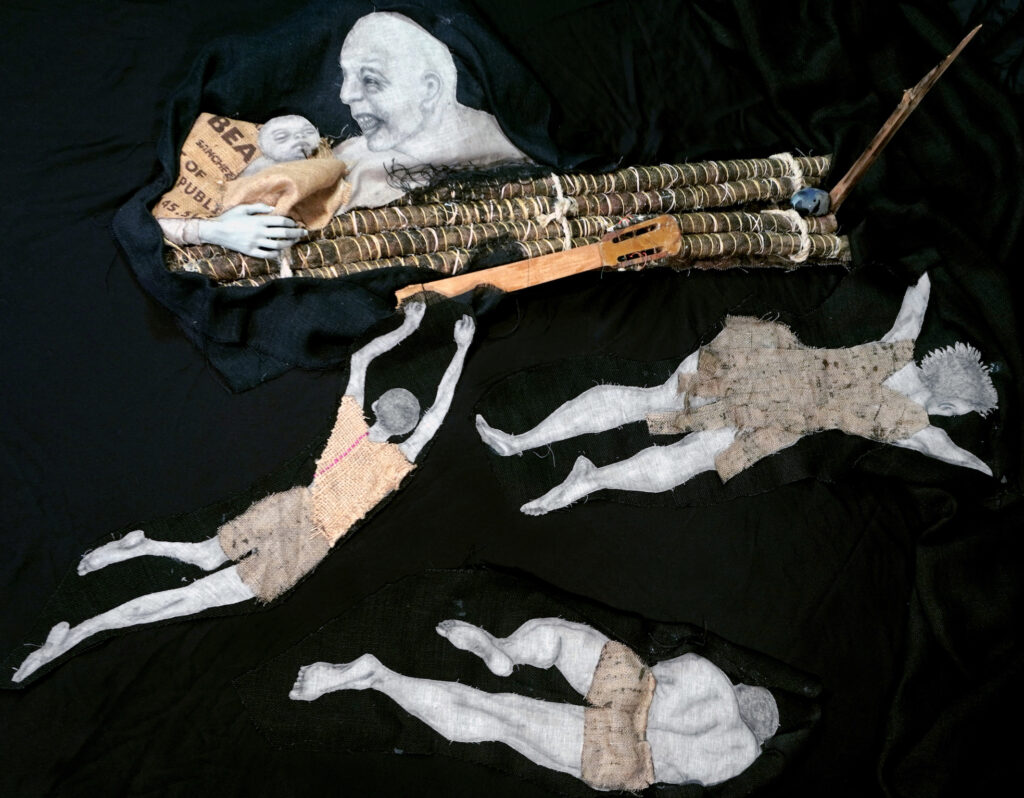
Pam Douglas has created an enormous – literally and figuratively – installation artwork in her Sanctuary series. The series is in three parts, with the second on view at TAG Gallery by appointment now through October 31st. It is filled with grace and power, as the artist uses sculptural and drawn images to create works that are visceral and resonant.

Creating a vital conversation about America’s ongoing humanitarian crises during pandemic times is difficult at best, and yet she has more than succeeded. Depicting both seeking, finding, and not finding sanctuary is the subject of the mixed-media series, which offers a look at those who seek by land, sea, and refugee tents.
In all three sections, viewers find themselves in an immersive and textural environment that seethes with the fury at the dehumanization of people seeking refuge. There is a cruelty that undercuts so much of this world, and Douglas does not shy away from revealing it in her limited but lovely palette, cerating images that appear bronzed by the elements.

Part One took viewers into a world of life-size drawings with sculptural elements that were displayed from floor to ceiling behind a chain link fence. Walking figures sought refuge; children were caged behind ropes.
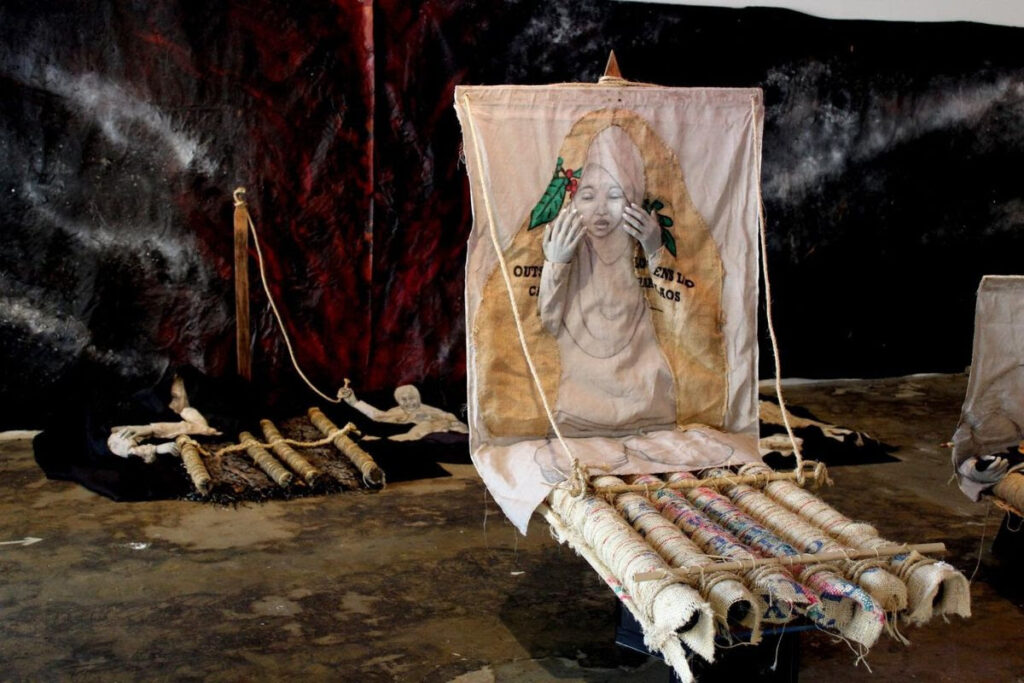
In her current Part Two, above, Douglas has created hand-made rafts built on “logs” shaped from burlap fabric and roped around foam rolls. Some she had covered with bark. The extreme tactility of these works engages the viewers’ senses as well as their eyes and hearts.
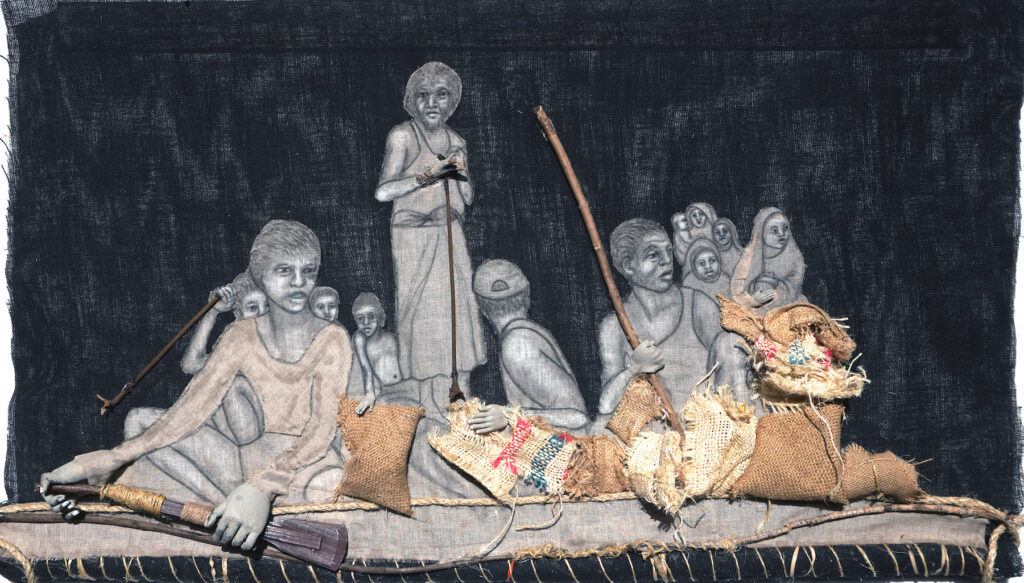
Douglas has also utilized sails made from the same canvas she works with in the other iterations of the series. Some of the rafts are even larger than the images she exhibited in part one, and rise 4 to 5 feet in height. They spread from a 36-foot abstract mural which also contains scraps of clothing and a clothes hanger. They echo the devastation the refugees are escaping from, making use of found objects such as rusty metal wires, discarded shoes, wood, rope and more.

The work is nothing short of dramatic, and Douglas herself describes her refugee rafts as seemingly escaping from that mural, which depicts a devastated land. The artist says she began the project last year as a response to refugees seeking asylum both on the U.S. Border and worldwide. “In 2020, the series grew into a metaphor for all of us adrift in the winds of change,” she relates.

For Douglas, as for many cultures, the raft itself has potent symbolic meaning. “The Buddha compared his teachings to a raft that helps us cross over to the other shore – the shore of peace, freedom, and well-being. Of course, rafts were entirely real for refugees from Cuba in the 20th century, and recently they’ve been a grim memorial for families trying to navigate the Mediterranean Sea fleeing climate disasters and wars.”

Shaped from simulated logs and tree bark, Douglas has created 12 rough crafts for Sanctuary Part Two, some afloat, some capsized, each 4 to 5-feet high. They fly canvas sails, with images of the raft passengers drawn in charcoal with great sensitivity and loving detail.
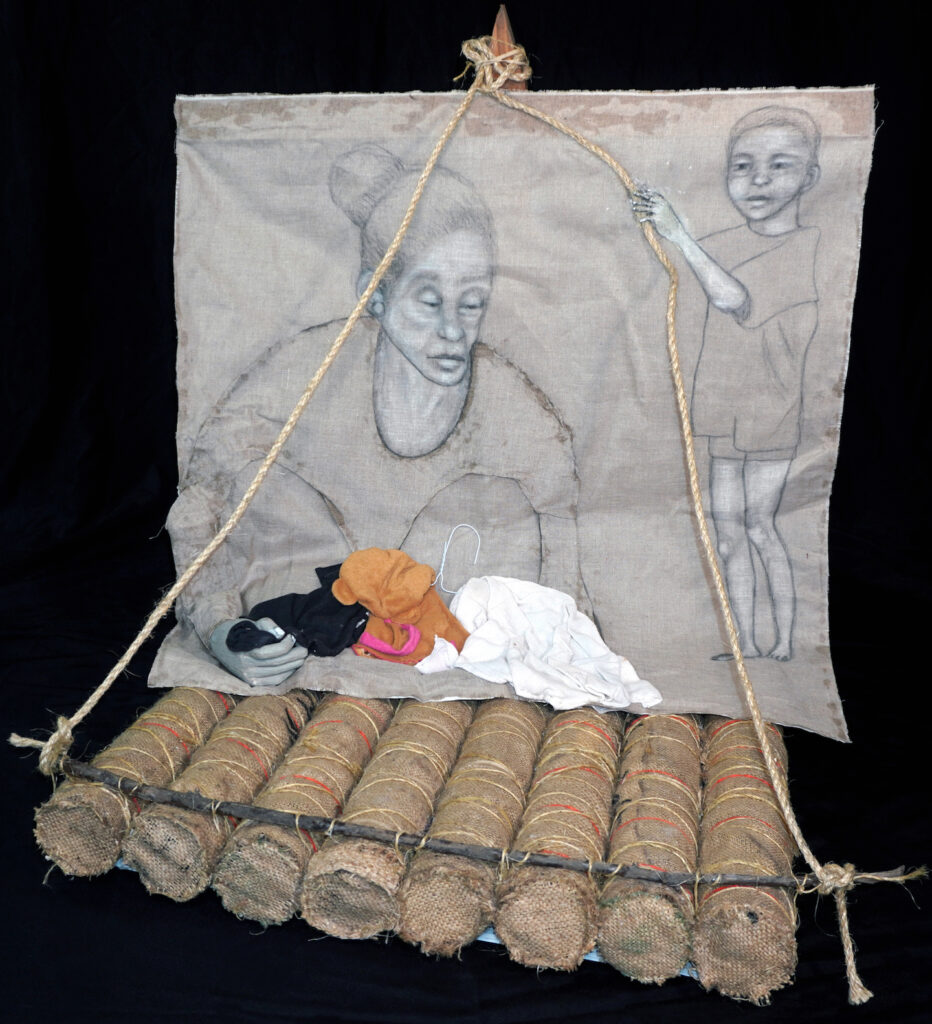
“Remnants of daily life such as a clothes hanger in ‘Grandma Tried to Dry Our Clothes’ (above) make these lives immediate,” Douglas attests. “In ‘Almost There’ a mother cradles her sleeping baby’s foot. In ‘Prayer for Safe Passage,’ a lone girl draped in a coffee bean bag conveys hope.”
Douglas powerfully weaves ordinary aspects of life with courageous ones through the people with which she has populated her rafts.
As with Sanctuary One, Part Two features her limited palette of charcoal and chalk on natural linen and tan burlap taken from coffee bean bags. Both muted and magical, the palette itself allows viewers to focus on “the struggle and the beauty of the faces.” Much like a newspaper image, the visuals seem to be drawn from daily photographs of the relentless struggle of immigrants, although Douglas notes that none of these figures are actually taken from newspapers.
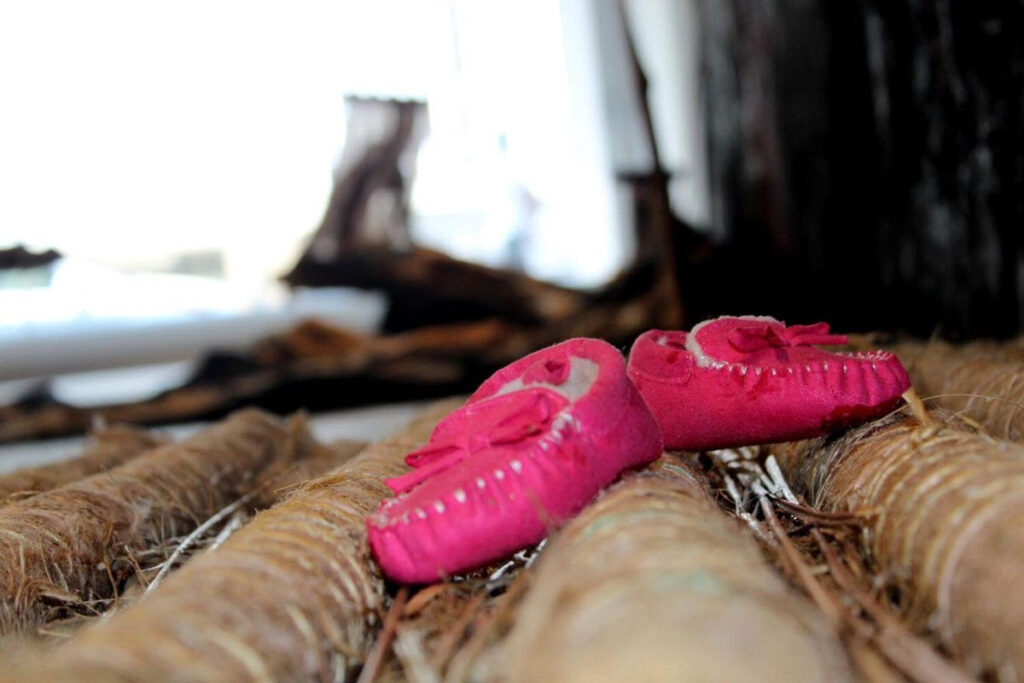
“I hope viewers comprehend the scale of Part Two that ranges from small details – like a mother’s hand clasping a baby’s foot, tiny praying hands atop a flagpole and baby’s shoes left on an abandoned raft – to a 36-foot painting, and includes intricate construction of rafts in plywood, bark, burlap, rope, twine and other materials. Compared to the wall-hung figures drawn on canvas in Part One, the rafts are a significant progression,” Douglas states.

It’s important to Douglas that viewers note the evolving conceptual advances in the series as well as the materials used and her own artwork. “Integrating drawing with physical artifacts in 3-dimensional space has been one of the challenges in Part Two,” she reports. “Looking at ‘Prayer for Safe Passage,’ for example, how does a drawn figure ‘kneel’ on a raft? How do her hands of clay emerge from the drawn body seamlessly? Where is the line between artifact and reality? This philosophical question grows throughout the series and will culminate in Part Three.”


She wants viewers to take special note of the continuing use of found and re-purposed materials similar to the used coffee bean bags she utilized in Part One. “From an environmental perspective, materials that are found in nature or recycled touch the soul of all three parts of the show: nothing and no one is a throw-away,” she asserts.
Following the October installation of Part Two, the entire Sanctuary exhibit including Part Three, Shelter, occupies all 6500 sq. ft. of TAG Gallery. The third installment will take place January 19 to February 13, 2021.
It’s envisioned by Douglas as a culmination of these travels, revealing poignant images of refugees arriving homeless to fabric-draped shelters. Again, she will create her figures drawn in charcoal in the same styles as in Part One and Part Two, but adding an additional element of pottery to her mixed media work.

“I think of Sanctuary as more than another art show. It’s also more than a social justice communication – though it has both of those qualities. I intend it to combine world-building and traditional art to create an encompassing experience for a visitor. I would like audiences to consider it innovative in a way that’s different from the way innovation is often conceived – as mostly technological. This is about the impact.”
It is indeed an impactful show. One cannot help but admire both the people she has created, the lives she has opened for viewers to experience and feel, as well as the skill, strength and passion of the art itself.
Currently, Douglas is involved deeply in creating Sanctuary Part Three. She says she is working on it every day. “Most of the tents and their inhabitants are now complete as is another 36-foot mural, this time a realistic landscape.” She notes that Part Three is around twice the size of Part Two, and similarly will feature free-standing hand-crafted structures that extend onto the gallery floor, with the show extending over two rooms, with the second large room serving as a simulated clinic. “That’s where I will be raising funds for Doctors Without Borders, thus completing the outreach into the real world.”
She will explore that idea more when the time comes. For now, the time requires – and I cannot use that word too strongly – viewers to more beyond the pandemic itself, and take in the inspiring, riveting, and richly moving work that is Sanctuary Two at TAG.
“When all three parts are assembled together as planned at TAG Gallery in 2021, the cumulative effect should be as devastating as it is immersive, leading viewers into a vital and multi-faceted experience,” Douglas says.
Sanctuary Part Two will be shown at TAG Gallery October 6 to October 31st by appointment; look for the online video link to come as well. Sanctuary One will run at LAAA October 30 through December 4th.
If you missed the virtual walk-through of Sanctuary Two earlier in October, look for LA Art Documents video available on YouTube towards the end of the month.
- Genie Davis; photos: Pam Douglas, TAG Gallery, Shoebox PR


